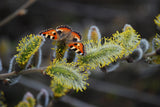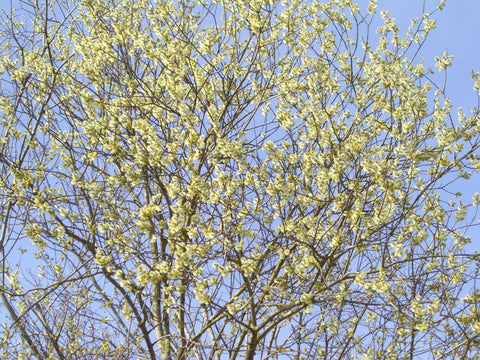One of the harbingers of spring is the Pussy Willow. These dioecious small trees prefer moist to wet soils, full sun, and room. The typical Pussy willow will grow to 15-20 feet tall and wide. There are 4 varieties of willows grouped into the pussy willow category and they all produce catkins in early spring. The males produce the larger showier catkins and the females the smaller greener catkins. The ones that are sold due to their colorful catkins are Salix discolor – silver catkins and native; Salix discolor rosea – small pink catkins and native; Salix caprea Rosea – larger pink catkins and from France; Salix gracilistyla Melanostachys – black catkins and from China; Salix chaenomeloides – black catkins and from Asia.
Other willows of interest are the variegated dappled willow or Salix integra Hakuro Nishiki (Japan) which produces variegated leaves ranging from pink to white to green. The Corkscrew (Curly) willow or Salix matsudana ‘Tortusa’ produces twisted branches that are often seen in dry arrangements
There are over 400 varieties of shrubs and trees in the Salix genus. About 12 are utilized in the landscape business. All share similar lanceolate leaves and are hardy to the Northern Hemisphere typically between zones 4-7. From the majestic weeping willow to the goat willow consider them short lived, fast growing, brittle and messy. They are also resilient if they break out and will continue to grow from suckers and roots. Willow shrubs produce twigs with catkins, the smaller trees produce twisted branches or flattened fan like branches that a
re often utilized in arranging, and the large trees are stately and magnificent planted around ponds, and in parks.

All willows are a vital early nectar source of food for pollinators. They are the larval host for Viceroy and Mourning Cloak butterflies and well as a wide range of moths. The Mourning Cloak over winters as an adult butterfly by hiding in the leaf litter or in broken branches of the willow. This is one of the only butterflies that overwinters as an adult and therefore is very early to appear.
Hummingbirds collect the old catkins to line their nest. They mold them into the nest walls that are often held together with spider web threads. This creates a soft lining for their young.
Despite their need for water and their relatively short life they are well liked and often utilized in many landscapes.

























